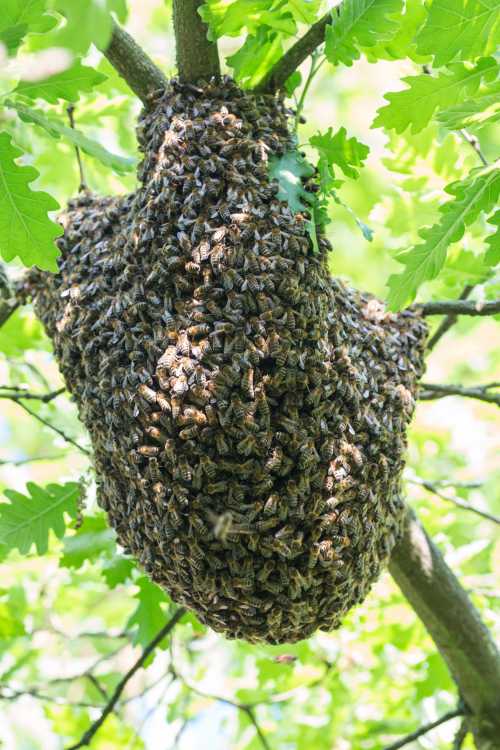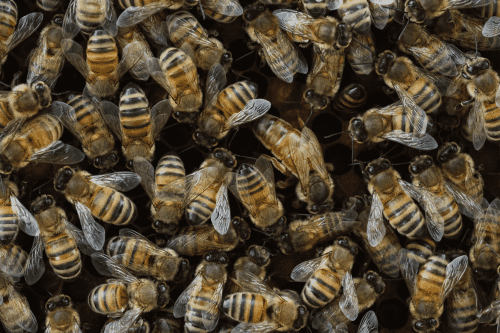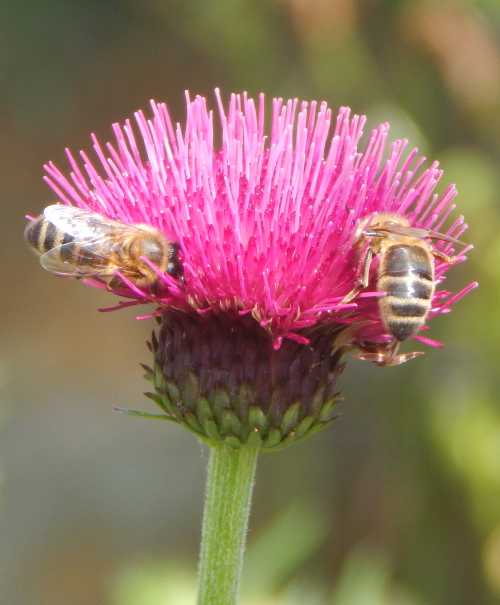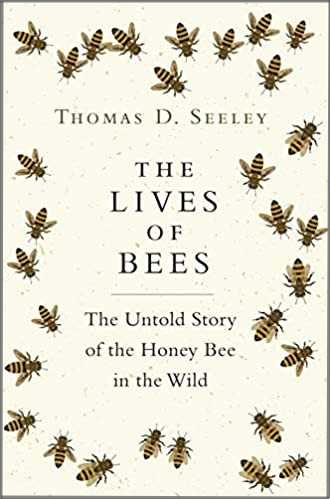Do Bees Drink Water?
Yes, bees not only drink water, they also have preferences as to the type of water they prefer to drink.
In a honey bee colony, some worker bees are assigned the special task of collecting water and returning it to the colony.
Here, we'll look at how bees drink and collect water, their preferred type of water, and why it's important for bees, plus how you can help bees by providing water.
6 Quick Facts About How And Where Bees Get Water
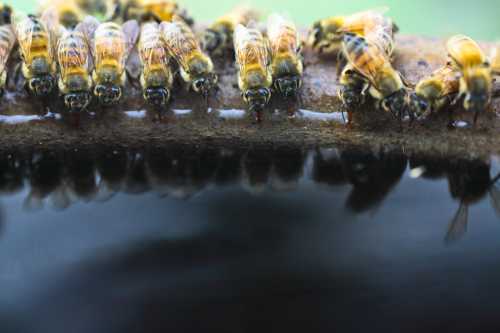
- Bees typically prefer 'dirty' water which could even be gathered from gutters, and puddles with cow dung or dog urine in them.
- Water might look dirty to us, but bees know when it's full of nutrients, and select it according to their needs. However, water that is contaminated with harmful chemicals can kill them.
- During their lives, some honey bee workers have the specific task of 'water collecting'.
- Bees can also collect water from 'guttation' - that is, water droplets excreted from a plant along the edges and margins of its leaves.
- Bees prefer water which contains minerals, and in particular, seem to like water that is slightly salty.
- The honey bee dance is not only for telling other colony members the whereabouts of flowers for food. Honey bees perform a waggle dance to inform other workers of the location of sources of water1.
How do honey bees get water to the hive or nest?
Within a colony, a number of honey bee workers performing the role of water collector, find a source of water, then drink the water and store it in their crops1.
When they return to the hive, the water is passed on to other honey bees at the hive entrance, and the water is then used in various ways.
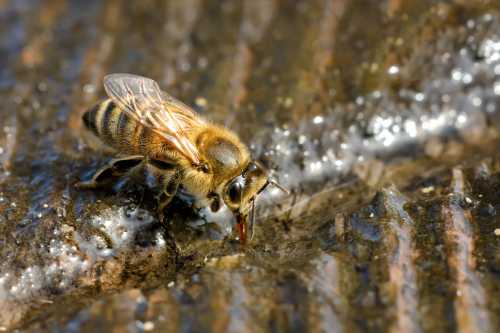 Honey bee collecting water
Honey bee collecting waterWhy honey bees need water - how they use it
Honey bees need water:
1. To help regulate conditions in the nest or hive
When the weather is warm, it can get hot in a hive or nest and bees can get thirsty.
In such conditions, the bees that receive the water from the collectors take it deeper into the hive and smear it on the walls of wax cells, or give it directly to other bees, or both2.
In dry climates, again water is needed to prevent the risk of brood drying out for lack of moisture1.
2. Rearing larvae
Nurse bees are responsible for feeding developing larvae. Nurse bees need lots of water (as well as nectar and pollen) so that their hypopharyngeal glands can produce jelly to feed the larvae1.
3. To gain nutrients
Research suggests that bees prefer water with particular nutrients, particularly if there is limited availability of those nutrients in nectar and pollen3.
4. To maintain health of adult bees
Just like humans, bees get thirsty, and water helps to maintain body fluid regulation (homeostasis) in adult bees.
Where do bees get water?
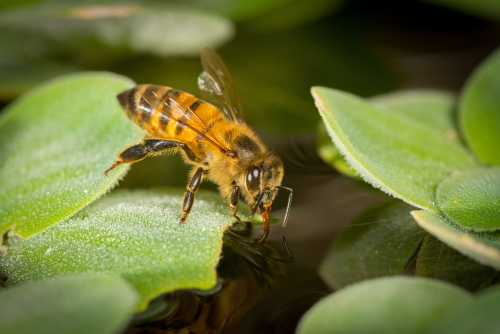
Bees gather water from a variety of places, but for their own safety, they need to collect the water without becoming submerged. Therefore, they 'perch' on a drier area, and dip their tongues into the water.
Here are several examples of potential sources of water for bees:
- Puddles
- Rainwater gutters
- Bird baths
- Pond edges
- Water splashes from the sides of swimming pools.
- Guttation (as pictured below)
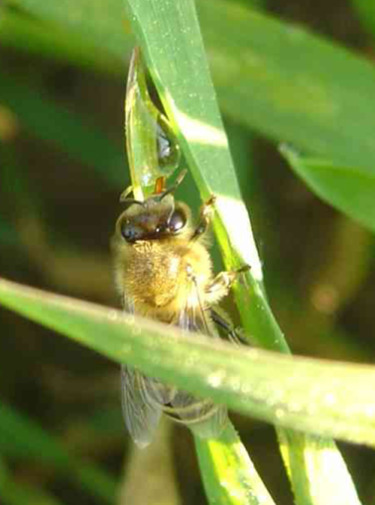 Honey bee Apis mellifera drinking plant guttation from a leaf.
Honey bee Apis mellifera drinking plant guttation from a leaf.Why do bees drink dirty water?
It's known that bees seem to like drinking dirty water.
That includes muddy puddles too, and gutters choked with decaying plant matter. In fact, provided they are free from harmful chemicals, puddles can potentially provide additional nutrients for bees!
Back in 1940, a British scientist. C. G. Butler decided to investigate why4.
Butler remarked that honey bees were observed to collect water on puddles on top of cow dung and sewage effluent, sometimes ignoring the 'clean' water provided for them by a beekeeper.
What Butler discovered was that the 'dirty' water sources targeted by bees offered higher levels of nutrients over clean water sources.
Later research has supported the work of Butler, for example, with Bonoan et al (2017) linking seasonality and availability (or lack of) nutrients in flowers (from pollen and nectar), with type of water collected for its nutrient content3.
Is dirty water dangerous for bees?
Water, and indeed guttation that is contaminated with insecticides or other harmful chemicals, can seriously harm or poison bees outright.
Bees desperate to find water to drink, or unable to detect the toxic chemicals, may ingest the toxic water.
How much water do bees drink?
This will vary depending on external conditions affecting the colony nest or hive (temperature and humidity levels), and development of the colony (number of larvae needing to be fed, and number of adults needing water).
Worker bees whose job is water collection, will regulate the amount of water they gather accordingly.
Can bees drown in water?
Yes! Bees cannot swim.
Don't leave buckets of water around your garden if you don't need them. Turn empty buckets upside down.
How to provide water for bees
If you would like to provide water for the bees in your garden, a small wildlife pond with a shallow edge is a great idea.
However, a fast and quick way to provide water for bees is to install a birdbath or shallow dish containing pebbles, and preferably with pebbles around the edge.
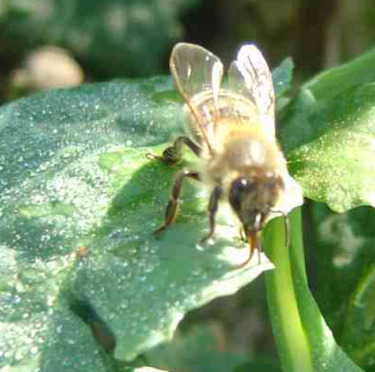
References
1. Madeleine M. Ostwald, Michael L. Smith, Thomas D. Seeley; The behavioral regulation of thirst, water collection and water storage in honey bee colonies. J Exp Biol 15 July 2016; 219 (14): 2156–2165. doi: https://doi.org/10.1242/jeb.139824
2. Kühnholz, S., Seeley, T. The control of water collection in honey bee colonies. Behav Ecol Sociobiol 41, 407–422 (1997). https://doi.org/10.1007/s002650050402
3. Bonoan, R.E., TAI, T.M., TAGLE RODRIGUEZ, M., FELLER, L., DADDARIO, S.R., CZAJA, R.A., O'CONNOR, L.D., BURRUSS, G. and STARKS, P.T. (2017), Seasonality of salt foraging in honey bees (Apis mellifera). Ecol Entomol, 42: 195-201. https://doi.org/10.1111/een.12375
4. Butler, G.C. (1940) The choice of drinking water by the honey bee. Journal of Evolutionary Biology, 27, 253–261.
If you found this page helpful or interesting, I'd really be grateful if you would share it with others - if not this page, perhaps another, such as Gardening For Bees.
Thank you so much :) .
